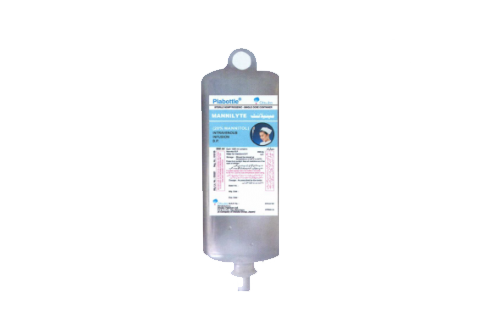
Standard Solutions -Mannilyte (Osmotol)
20% mannitol Intravenous Infusion B.P.
Therapeutic Class
Osmotic diuretic
Description and Composition
A clear, colorless fluid, each 1000 ml. of which contains:
| Mannitol B.P. | 200.0 grams |
| Water for Injections B.P. | q.s. |
Pharmacological Effects
- Large molecular size of this medication prevents its movement out of the vascular space. As such, an osmotic gradient is created which moves fluid from the tissues into the intravascular system.
- In the kidney, it moves into the glomerular filtrate which raises the osmotic pressure and induces diuresis.
- The pH range is 4.5 - 7.5.
Indications
- Treatment and prevention of cerebral edema.
- Reduction of intracranial pressure in neurosurgery.
- To reduce raised intraocular pressure prior to ophthalmic procedures.
- To increase urine flow in patients with acute renal failure.
- Promotion of excretion of toxic materials.
- Prophylaxis of acute renal failure.
Dosage and Administration
- The dosage and the rate of administration depend on the fluid requirements, urinary output, and the condition being treated. The usual adult dose ranges from 50-200 grams/24 hours.
- Reduction of intracranial pressure: In adults, usually 250-300 ml of the solution infused rapidly over 15-30 minutes.
- Diuresis: 50-200 grams over 24 hours in adults, preceded by a test dose of 200 mg/kg (about 60 ml in a 50 kg person) given over 3-5 minutes produces a diuresis of 30-50 ml/hour.
- Reduction of intraocular pressure: 1.5-2.0 grams/kg (about 10-13 ml/kg) over a period of 30 minutes to obtain a prompt and maximal result. The dose should be given 1-1½ hours prior to surgery to achieve maximal effect.
- Excretion of toxic materials: While using Mannilyte as an adjunctive therapy for excretion of toxic materials, the dosage depends on the fluid requirements and the urine output of the patient.
- The recommended dose for children is 200-500 mg/kg I.V. over 30-60 minutes.
Adverse Effects
- Chest pain, chills, thrombophlebitis, and visual disturbances.
- Hypertension.
- Congestive heart failure and pulmonary edema.
- Hypotension due to rapid volume depletion from large diuresis.
- Blurred vision and convulsions may occur.
- Nausea and vomiting may occur.
- Electrolyte depletion, especially sodium.
- Irritation, pain, and/or swelling at the injection site.
Contraindications
- Hypersensitivity to any component of the preparation.
- Dehydration.
- Electrolyte depletion and hypovolemia.
- Suspected intracranial hemorrhage.
- Congestive heart failure.
- Acute pulmonary edema.
- Renal failure, unless a test dose has produced a diuretic response.
Precautions
- Avoid use in pregnant women. Safe use of mannitol has not been established with respect to effects upon fetal development. It should not be used unless the potential benefits outweigh the possible hazards.
- Monitor ECG continuously.
- Monitor vital signs, level of consciousness, breath sounds, and urine output closely during administration.
- The patient should have a Foley’s catheter in place.
Osmolarity and Tonicity
Hypotonic solution as it does not contain any cations.
Hyper-osmolar solution (1098 mOsm/L)
Caloric Value
Nil
Pharmaceutical Precautions
- The solution is incompatible with any medication in syringe or solution, and whole blood.
- Crystallizes at any temperature but room temperature.
- If crystals are observed, the preparation should be warmed to room temperature before administration.
- Administration through a filter is preferable.
Packaging
500 ml in Plabottle.

